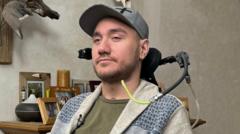The journey of 30-year-old Noland Arbaugh epitomizes the forefront of technology, showcasing the extensive potential and ethical concerns surrounding mind-reading devices powered by Neuralink’s innovative brain interface chip.
Mind-Reading Technology: The Future of Neuro-Interface Chip by Neuralink

Mind-Reading Technology: The Future of Neuro-Interface Chip by Neuralink
In a groundbreaking event for neurotechnology, Noland Arbaugh has emerged as the first recipient of a brain implant designed to translate thoughts into computer commands, developed by Elon Musk's Neuralink.
Having undergone a life-changing diving accident in 2016 that left him paralyzed from the shoulders down, Noland Arbaugh has made history as the first person to receive a neural interface chip from the Elon Musk’s company, Neuralink. The chip, which translates thoughts into digital commands, represents not merely a step forward for neurotechnology but a significant experiment in human-computer interaction.
With Musk’s polarizing legacy casting a long shadow over future advancements, Noland firmly emphasizes that the crux of this technology lies in its scientific implications, not in its celebrity entrepreneur. Though aware of the risks associated with the surgery, he is optimistic that his experience can foster valuable knowledge for future advancements.
The brain-computer interface (BCI) operates by detecting electrical impulses generated when thoughts of movement arise, allowing users to manipulate devices like computer cursors with mere intent. Despite its potential, Noland recognizes the dual-edged nature of such advancements, particularly concerning personal privacy. Experts have raised concerns about the implications of potentially granting access to private thoughts alongside the technology’s transformative possibilities.
Post-surgery, Noland quickly experienced the thrill of controlling a computer cursor with his thoughts, a vivid step towards independence he had long considered impossible. This newfound ability has rapidly advanced, allowing him to engage in activities he loved, such as playing chess and video games, receiving an enthusiastic affirmation of the chip’s practical capabilities.
While Noland represents a significant success story for Neuralink, the technology also raises questions about its reliability. During his trials, he has encountered issues, including a temporary disconnection that left him unable to use the device, highlighting inherent uncertainties tied to hardware designed to operate within the human brain.
Neuralink is not alone in pursuing this frontier; numerous companies are pioneering similar technologies with varied methods of implementation, including the less invasive Stentrode device by Synchron. As brain interface technology evolves, the narrative remains focused on both its revolutionary potential to reshape the lives of individuals with mobility challenges and the imperative need to address ethical complexities incentivized by such advancements.
Looking ahead, Noland aims to extend the capabilities of his BCI, aspiring to control his wheelchair or even a humanoid robot in the future. Reflecting on his groundbreaking journey, he believes that the process of uncovering the full potential of the human brain is still in its infancy. His story not only underscores the promise of technology but also challenges society to consider the ethical stakes intertwined with such advancements.


















